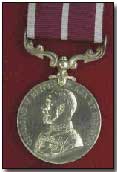Encyclopedia - Meritorious Service Medal
 The Meritorious Service
Medal, which was in existence prior to the First World War, was typically
awarded by British military authorities as a means of formally recognising
long military service or given acts of merit.
The Meritorious Service
Medal, which was in existence prior to the First World War, was typically
awarded by British military authorities as a means of formally recognising
long military service or given acts of merit.
The MSM (as it was known) was first issued in 1902 and was awarded to warrant officers and senior NCOs. Such servicemen were eligible for the award once they had received their army discharge after a period of at least 21 years.
With the vastly increased demand for medals generated by the First World War the MSM was, from 1916, also awarded for acts of gallantry or meritorious conduct when not in the face of the enemy (in which event other medals such as the MM, VC, etc were available).
Each 'Immediate MSM' - that is, those medals awarded for given conduct - was published in the London Gazette.
The medal itself was made of silver and was 36mm in diameter. The head of the monarch featured on the obverse with a crown and wreath, accompanied by the words For Meritorious Service, on the reverse. The ribbon attached to the medal was crimson with white edges and a central stripe.
A Bar was sometimes awarded for further acts of gallantry. Initially the number of medals in circulation was limited to just 40; in 1928 this was increased to 75 and to 100 in 1939. From January 1919 the Royal Navy similarly issued the MSM.
'Push' was slang signifying a large-scale attack upon enemy positions.
- Did you know?
